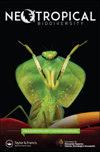Molecular characterization of mahogany tree (Swietenia macrophylla King, Meliaceae) in the remnant natural forest of Ecuador
IF 0.8
Q4 ECOLOGY
引用次数: 1
Abstract
ABSTRACT The Swietenia macrophylla King (Meliaceae) mahogany tree is widely spread in the neotropics. In Ecuador, it has a wide distribution range from the coastal zone to the Amazon. The mahogany tree is an endangered species due the overexploitation of the high commercial value of its wood. This study is aimed to characterize the Simple Sequence Repeat (SSR) variability of 123 trees selected from six provinces of Ecuador. The results showed that the natural mahogany population had a low level of genetic diversity (A = 6.9; Ho = 0.39; He = 0.43) and a significant heterozygous deficit inbreeding coefficient (F = 0.16). The probability of identity (PI) of the 12 microsatellite markers was low 4.3 × 10−9 and the cumulative exclusion probability of 99.99%. Additionally, the relatedness coefficient among individuals was −0.010 (se = 0.004). The genetic diversity among populations was moderate (ΦST = 8%). In addition, the structure analysis showed two genetic groups; however, it was possible to distinguish admixture within the entire range evaluated. These results show the need to establish strategies that allow the recovery and increase of the genetic diversity in natural populations, especially with the selection of trees to harvest seeds, as well as crossing the tree genetic pool to recombine their diversity.厄瓜多尔剩余天然林中桃花心木的分子特征
大叶甜木是一种广泛分布于新热带地区的红木树种。在厄瓜多尔,它有广泛的分布范围从沿海地区到亚马逊。由于其木材的高商业价值被过度开发,红木是一种濒危物种。本研究旨在分析厄瓜多尔6个省123棵乔木的SSR变异。结果表明,天然红木种群的遗传多样性水平较低(a = 6.9;Ho = 0.39;He = 0.43),杂合缺陷近交系数显著(F = 0.16)。12个微卫星标记的同源概率(PI)较低,为4.3 × 10−9,累计排除概率为99.99%。个体间亲缘系数为- 0.010 (se = 0.004)。群体间遗传多样性中等(ΦST = 8%)。此外,结构分析显示两个遗传群;然而,有可能在整个评估范围内区分外加剂。这些结果表明,需要制定策略来恢复和增加自然种群的遗传多样性,特别是选择树木来收获种子,以及穿越树木基因库来重组它们的多样性。
本文章由计算机程序翻译,如有差异,请以英文原文为准。
求助全文
约1分钟内获得全文
求助全文
来源期刊

Neotropical Biodiversity
Environmental Science-Ecology
CiteScore
1.80
自引率
0.00%
发文量
39
审稿时长
24 weeks
 求助内容:
求助内容: 应助结果提醒方式:
应助结果提醒方式:


